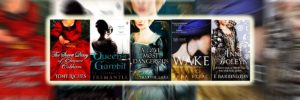In the third quarter of the year I seem to have been reading a lot of history. Apart from Bring up the Bodies by Hilary Mantel, which I’ve already written about, I’ve read three other works of historical fiction. (I’m wading through a fourth now.) I’ve also read a book of historical essays, a book about Marx and Marxism (at least tangentially historical), and a volume of 75 very short essays about historical photographs.
The three novels are Warlight by Michael Ondaatje, The Moor’s Account by Laila Lalami, and A Thousand Moons by Sebastian Barry. Three very different books in three very different styles (although, now I think about it, all of them written in the first person). And all both gripping and fascinating, each in its own way.
Historical fiction in the interior
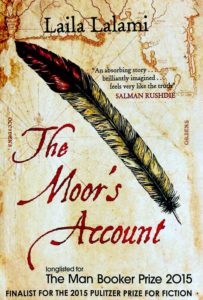
In The Moor’s Account, Laila Lalami tells the story of an ill-fated Spanish colonial expedition to Florida in the early 1500s. This is based on the true story of the Narváez expedition. Initially about 600 strong, the expedition landed in what is now the Tampa Bay area of Florida. They became lost in the interior and only four of them eventually found their way back to the Spanish Empire in Mexico some eight years later. Three of the survivors were Spaniards, the fourth was a Moroccan slave. He is the Moor, to whom Lalami gives a voice to tell the story from his perspective.
In Lalami’s novel, the Moor is Mustafa ibn Muhammad ibn Abdussalam al-Zamori. The Spaniards call him Estebanico. His fortunes fall and rise, over and again in the course of the novel. We learn how he sold himself into slavery in Spain to keep his family from starving. How he came to America with the Spanish. How his facility with languages, and his curiosity, intelligence, application and willingness to learn, enable him to save himself and his companions. They become a travelling troupe of herbalists and medicine men and, helping one another, achieve a degree of egalitarian brotherhood. But once they return to the Spanish colonies he finds himself still enslaved.
Though he longs to return to Africa, he never does. Still, the story ends on a positive note. (I’m not going to elaborate on that.)
Cover artwork sells
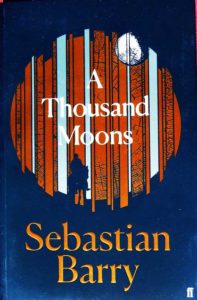
I bought Sebastian Barry’s book, A Thousand Moons, almost exclusively because of the artwork on the cover and the quality of the paper and binding. I knew nothing about the author, and the story as described in the book’s blurb didn’t seem to be up my street at all. A kind of Western, set in Tennessee after the American Civil War. This was in the bookshop at Gatwick airport where I bought some of the books I read earlier in the spring. They were running a two-for-the-price-of-one-and-a-half, so I took this book in part simply to make up the numbers. What lessons to draw from that? Don’t skimp on the cover art or the material quality of the printed book, and put more effort into writing the blurb perhaps.
Winona
Barry’s novel turned out to be the sequel to an earlier book, Days without End. Perhaps stand-alone sequel, since I didn’t feel that I was missing anything coming cold to read this book. A story about tolerance and humanity at time when both are under attack. A story for our time. The narrator is Winona, a 16 year old Lakota girl. Her real name is Ojinjintka, but she goes by Winona, she says, because those around her find it “easier in the mouth”. Me too.
Told intimately in the first person, Barry gives Winona a very specific voice with a fascinating vocabulary that mixes 19th-century literary English, frontier Americanisms and the occasional Native American expression. An orphan, and far from her tribal homelands, she lives with a disparate group of people, discharged unionist soldiers and freed slaves, in a kind of proto-commune outside of Paris in western Tennessee.
The story is set towards the end of the Reconstruction period. Racial tensions, local frictions between former Unionists and former Confederates, political bribery and corruption charge the story. When Winona is raped, she is uncertain by whom, she takes up arms and rides off in search of justice.
Sebastian Barry is an Irish author new to me. Wikipedia says “He is noted for his dense literary writing style and is considered one of Ireland’s finest writers.” I need to read more of his writing. Days without End, I understand, tells the story of Irishman Thomas McNulty, a peripheral character in A Thousand Moons. Maybe that’s where I should start.
London fog
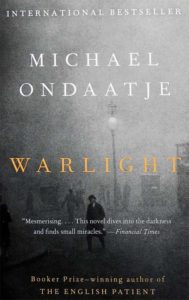
My third historical novel, Warlight, is set in two periods: in England, in and around London, in 1945-46, and in Essex and London about 14 years later.
The narrator is Nathanial, aged 14 in 1945, 28 in 1959. In 1945 Nathaniel’s parents leave him and his 16 year old sister Rachel, apparently to do government work in Singapore. The children are left in the guardianship of Walter, a man they call The Moth. The first half of the novel is taken up with the two children living with The Moth and his associates on the edge of legality. The children have no contact with their parents and begin to drift apart from one another. It’s as though they are losing themselves in the London fog. A growing sense of threat hangs over them and culminates in an assault which leaves The Moth dead, but brings their mother back to them.
In 1959 Nathaniel works for the British Secret Service. His mother is dead, murdered we learn. His job is to identify and destroy documentation of the dirty operations the Secret Service carried out in the late 40s. Bringing to an end the partisan groups they had earlier sponsored to fight the Germans. Now, in peace time, the continued activities of these groups were no longer welcome. In this way Nathanial discovers that his parents were almost certainty Secret Service agents and begins to shed a little light on his teenage experiences.
I thought this was a powerful novel and especially the picture of London in the period just post-war wonderfully conjured up.
The Lymond Chronicles
During the novel writing course I followed in May/June, I was recommended to read the novels of Dorothy Dunnett. The recommendation was made, perhaps, because I included a peripheral Scottish character in one of the scenes I shared with my course participants. Perhaps, more disturbingly, because my writing style comes across as similar to Dunnett’s. Or because I was being encouraged to aspire to her style. Hard to say. And after the passage of two months I don’t feel I can go back and ask.
The Lymond Chronicles are series of novels; six of them I think. Judging by the first they are set in and around Scotland, more or less in the same period as Elin’s Story. (Actually the action seems to be taking place roughly 20 years earlier.) Originally published in the 1960s, they took a bit of tracking down. I’m now about half way through The Game of Kings, the first volume.
I’m finding it a difficult and frustrating read.
Sesquipedal
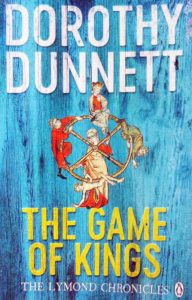
There’s certainly a good story here, and it breaks through often enough to keep me hooked. But to reach it there’s a lot of verbiage to hack through. Dorothy Dunnett has absorbed the style of Walter Scott and taken it to a prolix, not to say sesquipedalian, extreme. Her principle character is Francis Crawford of Lymond, Master of Culter. (And all those names are used to identify him, repeatedly, both on their own or mixed together in various combinations. But that’s about par for the course. All the characters have multiple names.)
Crawford, I’ll stick with that, usually manages to squeeze Latinate words, French quotes, obscure literary references and snatches of Scots dialect poetry into every long speech. Unfortunately Dunnett herself gets carried away too. Crawford’s first appearance is swimming secretly into Edinburgh behind a smuggler’s rowing-boat. Except he isn’t swimming, he’s “parting the flat waters … like an oriflamme in the wake of the boat.” A little later he doesn’t just get off his horse, he dismounts “emitting a feu de joie of explicit orders.” The Oriflamme was the mythical war banner of St Denis, under which French kings led their troops into battle. A feu de joie is a bonfire. Yes, I can see how they work in both sentences, but with the best will in the world you couldn’t call them transparent.
If anything is likely to encourage brevity in my own writing it would be wading through Dorothy Dunnett’s prose. Perhaps that was what the recommendation was intended to achieve?
The rest is silence…
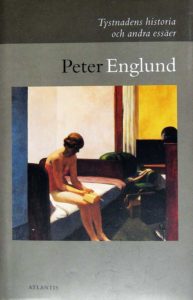
When I started this, I was planning to say something about the historical non-fiction I’ve been reading too. Peter Englund’s book of short, historical essays Tystnadens historia (A History of Silence) deserves more space. But I’m not going to say any more than that I read it with great pleasure and I wish it was available in English.
Terry Eagleton’s Why Marx Was Right is good in patches, though it seems to gloss over a number of thorny issues. It also manages to telescope the Russian February and October Revolutions. It suggests the former, which broke out on International Women’s Day, somehow makes Marxism (and Leninism) into a feminist movement. The last chapter in particular strikes me as rushed and weak on both Feminism and Environmentalism.
Final there’s that book of photography: Sjutiofem fotografier by Jakob Wiberg. An album of 75 historical photos taken between 1845 and 1989. Many of them are iconic, but several are parochial to Swedish history – as you’d expect. The author writes for a Swedish monthly magazine of popular history (Populär historia) and these pictures and accompanying essays all originally appeared there.
The author’s apology
This blog post has taken far too long to write, and probably far too long to read. Sorry about that! When I started writing reading diary posts some years ago, I was usually publishing two blog posts a week. Now I’m down to one, but I can’t get away from the idea that I need to report on all the books I’ve been reading. I will try to do better – write less – in future.
Too Long Didn’t Read – all the URLs
Author links go to the author’s home page or nearest equivalent where I can find one. Books link to their entry on GoodReads or, in the case of the last in the list, to the Swedish on-line book store Bokus.
- A Thousand Moons by Sebastian Berry
- Days without End by Sebastian Berry
- The Game of Kings by Dorothy Dunnett
- Why Marx was Right by Terry Eagleton
- Tystnadens historia och andra essäer by Peter Englund
- The Moor’s Account by Laila Lalami
- Bring up the Bodies by Hilary Mantel
- Warlight by Michael Ondaatje
- Sjutiofem fotografier by Jacob Wiberg




